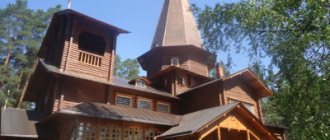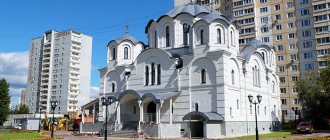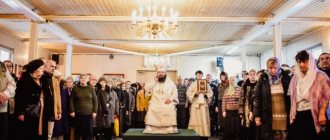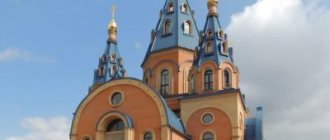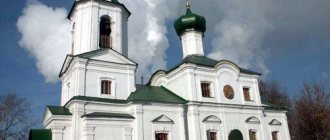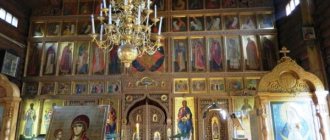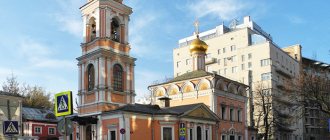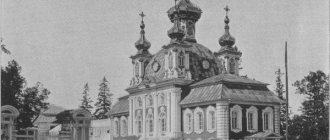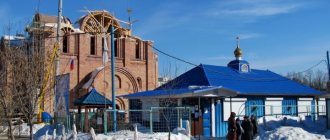One of the modern tented churches in the traditional Russian style from the times of Kievan Rus is the Temple of Seraphim Vyritsky, which is located in the urban village of Vyritsa, Gatchina district, Leningrad region.
The Temple of Seraphim of Vyritsky was consecrated in honor of the Kazan Icon, but most often it is called by the name of the saint who labored here for a long time - in honor of the Monk Seraphim of Vyritsky. St. Seraphim was born in 1866, came from a peasant family and was forced to go to work early because his father died.
He worked as a delivery boy in a shop in St. Petersburg, got married successfully, acquired a large fortune, and got married. In 1920, he decided to become a monk at the Alexander Nevsky Lavra - his wife followed his example and also became a monk; they donated all their wealth to the needs of the monasteries.
In 1926, he accepted the schema and became the confessor of the Lavra. In 1933, he moved to Vyritsa and lived here until his death in 1949. He received pilgrims and those in need of spiritual guidance here, and had a prophetic gift. Many of his prophecies about the fate of the world and Russia have been preserved. Now the relics of the saint are in the chapel on the territory of the temple.
Now the temple in Vyritsa is an important historical and pilgrimage center for Orthodox believers. People who are directly related to St. Seraphim are still alive - his great-great-grandchildren and residents of Vyritsa who knew him personally. People come here to pray and for spiritual intercession.
Today, the Temple of Seraphim Vyritsky is one of the pristinely preserved rare tent temples of great cultural and religious significance.
Architect, exterior decoration, architectural ensemble
Of the five submitted projects for the construction of the temple, the project of architects M.V. Krasovsky and V.P. Apyshkov was chosen by a majority of votes. The popularity of their project was due to the idea of tented churches, which was close in Russia, and the professionalism of the architects.
Apyshkov was a master of tent construction and back in 1919 he wrote a large-scale work “Russian Wooden Architecture,” and Krasovsky worked on studying the traditional art of architecture in Rus', and in particular on Moscow architectural monuments.
Temple of Seraphim Vyritsky, Vyritsa, external decoration.
The church followed all construction rules, using the latest materials and technologies at the time of construction. It is a prominent representative of the traditional type of tented temples; it has a lower level - a basement, and a gallery on top of the basement surrounding the temple - a walkway. The structure is entirely made of wood.
In addition to the temple, a wooden chapel was later built on the territory in the same style. The Kletsky style can be traced in architecture and technology - a log house covered with a roof. Later, wooden buildings were completed: church benches, a refectory, a Sunday school, and a water well was equipped.
Laying the stone temple
In 2005, two significant events took place at once - Archpriest Valery Klimenkov became rector and chairman of the parish council, and at the same time the stone church of Seraphim Vyritsky (in Kupchino) was founded. This event occurred on September 18, immediately after receiving a construction permit from the relevant administrative authorities. It is important to note that the work begun did not prevent the restoration of the burnt chapel, and in the same year, divine services in it resumed in full.
As you know, any construction requires significant material costs. The Church of Seraphim Vyritsky in Kupchino was no exception. The rector, Father Valery, showed extraordinary energy and organizational skills in this matter, managing to attract not only a wide range of donors from among future parishioners, but a number of fairly large St. Petersburg entrepreneurs to finance the project. As a result, the problem was solved, and in 2007 the construction of the lower basement of the temple was completed. In January of the following year, the first divine liturgy was celebrated there.
History of construction
The Church of Seraphim Vyritsky in Vyritsa began its history simultaneously with the design of the village “Princely Valley”, conceived as a holiday village in 1910 by Prince P. Wittgenstein. Lands far from St. Petersburg were divided into plots and sold well, and soon Vyritsa became an active settlement with a large number of residents, who soon needed their own church.
During the initial street markings, a place for the temple was immediately allocated, but the construction itself never began.
2 years later, in August 1912, at a general meeting of residents, the need to build a church soon was approved. The site, previously allocated for construction, turned out to be inconvenient for various reasons: it was in a hard-to-reach place and interfered with already laid roads.
Residents were offered to buy another plot of land - despite the fact that it was more expensive, thanks to the prince they managed to get a big discount. Through the efforts of the residents, the missing amount was collected, and the prince himself paid another half of the cost. To prepare documents for the site and construction of the temple, the Brotherhood of the Kazan Icon of the Mother of God was organized, which became the backbone of the future community.
Construction of the temple began just in time for the upcoming holiday - soon the whole country was going to celebrate the 300th anniversary of the Romanov dynasty. A competition was announced for the design of the temple, of which 5 works became finalists. The project of the tented church was approved by general vote. The Brotherhood dealt with all financial issues of construction.
Through their efforts and with the help of the prince, a plot was acquired and the necessary timber for construction was purchased. In order to increase the status of the temple, the significance of its construction and to receive help in the future, the Brotherhood turned to Prince John Konstantinovich. He was asked to become chairman of the Brotherhood, to which he immediately agreed.
Already in July 1913, at a solemn service, the Bishop of Tobolsk laid the first cornerstone, and by winter the church was already built: the walls and roof were ready, a fence was erected around the site, and interior and finishing work began in the spring.
In 1914, crosses and bells were brought to the temple. On August 8 of the same year, the temple was consecrated, but due to the outbreak of war, Prince John was unable to attend the celebration in person. Since the temple was wooden and there was no heating in it, services were held in it exclusively in the summer.
The temple was slowly developed: in 1921, instead of the existing iconostasis, an iconostasis from the previously closed shelter church was installed here. Here, after the closure of the Neva Lavra, Seraphim Vyritsky stayed and served. During the period of Soviet power, the temple was not closed immediately, only in 1938.
The headquarters of OSOAVIAKHIM is located here, a defense organization dedicated to training citizens to help defend the country. Despite the conflict between church and religion, parishioners were able to keep almost all the temple utensils intact. Icons, vessels, and interior decorations were hidden throughout the houses; they even managed to preserve the priest’s vestments.
In 1941, German troops entered Vyritsa. During negotiations with the command, their consent was obtained to open the church for worship. This decision was largely influenced by the fact that there was a Romanian unit here, in which the majority were Orthodox.
The church did not close again, but the authorities still interfered with the functioning of the temple in every possible way, in particular, by refusing registration to various priests, which could eventually become a pretext for closing the temple.
This was avoided thanks to the activity of the parish; they wrote letters and petitions that reached the supreme authorities and even the Presidium of the Supreme Council. In 1966 the battle for the temple was won and a permanent priest was appointed.
Don't miss the most popular article in the section: Metro Nizhny Novgorod. Diagram, map, description.
Chapel arson
To the great chagrin of the parishioners, who put a lot of work into building the chapel, it was set on fire twice. The first time this happened was in the fall of 2004, when as a result of a fire the interior was completely burned out and the roof was badly damaged.
But as witnesses of that sad event say, at the same time a miracle was shown to console the believers. Despite the fact that the flames were raging in the chapel, the icons of the Lord Pantocrator and the Most Holy Theotokos located in it were practically not damaged, and the aluminum baptismal font located between them half melted from the intense heat. The second time the arson was committed in 2010. Then the roof was badly burned.
Interior decoration
Despite all the hardships that befell the temple, its interior decoration was preserved intact. The temple has never been repaired, altered or reconstructed; it has managed to preserve all its original beauty. The temple has oak iconostases: in the southern aisle there is a two-tier iconostasis, which previously stood in place of the central one.
This iconostasis was created according to the drawings of the architect Krasovsky. The modern central iconostasis was brought from another, closed church, along with choirs and icon cases for large icons. Inside, the temple combines the beauty of the Russian style of architecture and the severity of the icons of Greek canon writing.
In the altar there is a marble throne, unchanged since the consecration of the temple, the church is illuminated by a bronze chandelier on crystal chains. The church can accommodate about 700 people.
70 years have passed since the repose of St. Seraphim of Vyritsky
His Eminence was co-served by the vicar of the Alexander Nevsky Lavra, Bishop Nazariy of Kronstadt, Bishop Mstislav of Tikhvin and Lodeynopol, Bishop Seraphim of Peterhof, Archpriests Gennady Zverev, Vladimir Feer, Pavel Feer, Nikolai Denisenko, rector Archpriest Georgy Preobrazhensky, hieromonks Kirill and Methodius (Zinkovsky) and other sacred ministers . Bishop Mitrofan expressed gratitude to the episcopate and clergy for the joint prayer and joy of the common holiday on the anniversary day of memory of St. Seraphim of Vyritsky. He also expressed gratitude to Valery Filimonov, the author of the life, books and film about the monk, for his work in glorifying him. Bishop Nazariy of Kronstadt conveyed a blessing from Metropolitan Barsanuphius of St. Petersburg and Ladoga. +++ In the church of the Bolshoi Gostiny Dvor, dedicated to the saint, the Divine Liturgy was performed by the assistant to the dean of the Central District, Archpriest Alexander Rumyantsev, co-served by the rector, Priest Artemy Naumov, and the clergy of the temple. The chairman of the Union of Orthodox Entrepreneurs of St. Petersburg, Vladislav Zhukovich, prayed during the service. A funeral litany was held in memory of the victims of the terrorist attack in the St. Petersburg metro that happened two years ago. “The works of our venerable and God-bearing father Seraphim Vyritsky are truly amazing,” Father Alexander said in his sermon. “He was a peasant, then a merchant, and ended his life as a schema-monk. In all classes, at all stages of life, he sought first of all the Kingdom of Heaven and was a citizen of it. We all have something to imitate him in. And he, in turn, imitated St. Seraphim of Sarov. I would like there to be shepherds among us whom we would like to imitate. Each of us must become a citizen of the Kingdom of Heaven, as St. Seraphim strived for this. Today is seventy years since his death, and there are still people in our city who saw him alive and received consolation from him. He had a gift: he spoke equally freely with all people, regardless of class, and with common people, and with learned people, and with bishops. In modern life, classes have been erased; the only thing that has survived is the clergy. And it is the Church that needs to become the foundation of society. This is the only thing that has survived from Russia, which was great and powerful. At the same time, this is the foundation on which Christ laid His Kingdom.”
In honor of the memorable date, Priest Artemy Naumov and Vladislav Zhukovich fired a midday shot from the Naryshkin cannon of the Peter and Paul Fortress. The ceremony was attended by the Chairman of the Board of the Association of Industrialists and Entrepreneurs of St. Petersburg, Sergei Fedorov. The celebration continued in Apraksin Lane, near house 20, where the monk lived and a memorial plaque was installed. Priest Artemy Naumov served a prayer service to the saint. Among the worshipers was the head of the Central District Administration, Maxim Meiksin. “Vasily Muravyov once lived and worked in this house,” said Father Artemy. - In the kontakion of the holiday there are the words - “thou hast fought a good fight.” His most important feat is that he remained in the Fatherland during a difficult, bloody moment of history, together with the people, giving away all his property. He prayed and asked God that peace and piety would be restored in Holy Rus'. There are always difficulties, at any stage of human history, but we do not lose heart and ask our heavenly intercessors, among whom is St. Seraphim, to pray to God for us.” “Today is a significant day for Gostiny Dvor,” said Nadezhda Tushakova, chairman of its board of directors. — When the future Venerable Seraphim’s father died, his mother sent him to work in St. Petersburg. His uncle was a merchant in Gostiny Dvor, so Vasily began his career there. At first he was an errand boy, then he was assigned to the fur business. He became one of the most famous merchants in the fur trade in Russia. When the revolution happened, he was a rich man, he was offered to go to the West, but he refused, because from an early age he dreamed of serving God. First he served in the Alexander Nevsky Lavra, then in Vyritsa. He had a great gift of consolation. He helped hundreds of people survive the war. Gostiny Dvor is lucky: Saint Seraphim is always before our eyes, we pray to him, we feel his help.” Vladislav Zhukovich noted that entrepreneurship is a great responsibility, and expressed regret that the word “entrepreneur” is not freed from negative connotations: “We need to look into the golden age of entrepreneurship, when merchants and industrialists, who came from ordinary peasants, worked and diligently exported , built churches, schools, theaters, hospitals, preserved cultural heritage - helped musicians, writers, composers. There were great merchant dynasties. Among the great names is the name of St. Seraphim, also a native of peasants. He was engaged in business not because he liked it, but because he did not receive the blessing to serve God: his confessor told him to live in the world and start a family. In seven years, from an errand boy, he rose to senior clerk. When he came to serve at the Alexander Nevsky Lavra, he was an ordinary sexton, and within six years he became the monastery’s confessor, because while still in the world he was preparing his heart for something greater. This means that you can live in the world and achieve success in business without contradicting your conscience, thinking not only about material things. The monk reveals all this to us.” Flowers were laid at the memorial plaque. The Church of St. Seraphim Vyritsky in Gostiny Dvor was built in a separate ancient building in 2014 and consecrated with a small rite on June 9. At the same time, the first Divine Liturgy was celebrated there. The dedication of the temple is not accidental: the trading establishment played an important role in the life of the future saint. Here he began his merchant career as a ten-year-old boy. Having achieved unprecedented success in his work, he distributed all his enormous property to the poor and dedicated his life to God. In the same building there is a museum of the history of merchants of St. Petersburg and Russia. A memorial plaque to the saint was unveiled at house 20 in Apraksin Lane, where Vasily Muravyov, as a merchant, lived from 1914 to 1917. News Agency "Living Water"
Shrines and relics of the temple
One of the most important shrines of the temple is the image of the Kazan Icon, which belongs to the Muravyov family, which includes the Monk Seraphim Vyritsky. Of his shrines, his stole is also kept in the temple.
The temple contains many icons with particles of relics, such as icons of Seraphim of Sarov, Great Martyr Catherine, St. George the Victorious, St. Nicholas, and others. Also kept in the temple is a gift for the consecration of the church, sent from Jerusalem by the patriarch: an icon of the Resurrection with a piece of stone from the Holy Sepulcher.
About today's life of the temple
In 2012, significant finishing work was carried out, giving the entire building a finished and formal appearance. However, during the subsequent period, builders and artists made additions in accordance with the general artistic intent of the authors of the project. Its implementation allows us to say that today one of the most interesting temple buildings in recent years is the Church of Seraphim Vyritsky in Kupchino. Reviews from grateful visitors are clear confirmation of this.
Even a quick glance at them shows that parishioners and guests are very grateful to the people who put their labors into building the temple and organizing its internal life. A lot of warm words are addressed to the creators of the church choir, whose singing accompanies the services, as well as to the organizers of the Sunday school, in which both children and adults study.
For all guests of St. Petersburg and residents of the city, we provide basic information - the address where the Church of Seraphim Vyritsky is located in Kupchino, the schedule of services: St. Petersburg, Zagrebsky Boulevard, 26; on Wednesdays, Fridays, Saturdays and Sundays, divine liturgies are held at 10.00, and all-night vigils at 18.00.
Clergy, mentors
Since 2005, Archpriest Georgy (Preobrazhensky) has been the rector and confessor of the church. He was born in 1972 and studied at the St. Petersburg Seminary. He was ordained in 1995, and in 2005 he was transferred to the parish in Vyritsa.
Archpriest Georgy belongs to a priestly family: his great-grandfather, grandfather and father were also famous priests, graduates of the seminary, and their destinies are firmly connected with the fate of St. Petersburg and its church history.
Archpriest Pavel (Kiselev), priest Konstantin (Lebedev) and hieromonks Kirill and Methodius (Zinkovsky) will also serve in the church. All of them are graduates of the St. Petersburg Seminary and Academy, have teaching experience and high church awards. Also on the church staff are deacons Sergius (Chekodanov), Lev (Sviridov) and Maxim (Kruptsov).
Temple of St. Seraphim Vyritsky in Kupchino, St. Petersburg
About the temple
In the fall of 1999, an initiative group was formed to resolve the issue of the need to build a temple in the southern part of the Kupchino district.
Upon completion of approvals with the District Administration and the St. Petersburg Diocese, under the chairmanship of the dean of the Nevsky District, Rev. Victor Golubev, a founding meeting was held, at which a parish was created in the name of St. Seraphim of Sarov (later in the name of St. Seraphim of Vyritsky after his glorification as a saint). After joint work with G. Sokolov’s ArchStudio on the design of the future stone temple, the “Investment and Tender Commission of St. Petersburg” decided to allocate a site for the construction of the temple. In 2001, after the order of the Governor of St. Petersburg to approve the decision of the ITK, a lease agreement was concluded for a land plot, on which in the summer of 2002 parishioners began work on their own to prepare the territory (removing the top layer of soil, backfilling, etc.) and installing temporary structures: chapels and utility rooms. In October 2003, the installation of the frame of the wooden chapel, decorated with a dome with a cross, a bell tower and a carved porch, was completed.
For the spiritual care of the parish in the spring of 2002, by decree of Metropolitan Vladimir, Fr. Nikolai Mochalkin, priest of the temple in the name of Job the Long-Suffering. On Sundays they served prayers and memorial services. In the fall of 2004, an arson was committed in the chapel, as a result of which the inside of the altar burned out and the middle part of the chapel was badly damaged.
During the fire, a miracle happened - the icon of the Lord Pantocrator and the Vladimir Icon of the Mother of God, located in the altar, did not burn, and the aluminum baptismal font was half melted.
In April 2005, by Decree of Metropolitan Vladimir of St. Petersburg and Ladoga, Archpriest was appointed rector and chairman of the Parish Council of the parish in the name of Seraphim Vyritsky. Valery Klimenkov. Having completed the restoration work, in the summer of the same year the first Divine Liturgy was celebrated in the chapel and a circle of statutory services was established. By July, permission was received from GATI and GASN for construction work on the construction of a stone church in honor of St. Seraphim Vyritsky in Kupchino (at the intersection of J. Hasek St. and Zagreb Boulevard). On September 18, 2005, with the blessing of Metropolitan Vladimir of St. Petersburg and Ladoga, the founding ceremony of the church took place.
With God's help, with donations from parishioners and entrepreneurs, the construction of the lower basement church was completed in June 2007. On January 6, 2008, on the eve of the celebration of the Nativity of Christ, with the blessing of Metropolitan Vladimir of St. Petersburg and Ladoga, the first Divine Liturgy took place in the lower church.
On December 2, 2010, a dome and a three-meter eight-pointed Orthodox cross were installed on the twenty-eight-meter-high erected walls. On the day of the Great Feast of the Holy Trinity, 06/12/2011, the first Divine Liturgy took place in the upper church under construction in the name of St. Seraphim Vyritsky.
Social work, everyday life
Since 2010, there has been a temperance society at the temple. Every year, more than 200 people seek help in overcoming alcohol addiction. Members of the society are offered individual consultations with an Orthodox psychologist, and special programs are developed for personal growth and recovery from addiction.
Thanks to this, it becomes possible to send those who wish to rehabilitation centers. General conversations, catechesis, and general confessions are also held. Joint akathists are held monthly in front of the Inexhaustible Chalice icon. Every year there is a general religious procession with the icon around Vyritsa.
For rehabilitation, participants in the temperance society are required to participate in obedience on the temple grounds. Participants in the temperance society, if desired, take a vow of sobriety in front of the icon.
Russian Orthodox Church Moscow Patriarchate St. Petersburg Diocese
Dear brothers and sisters!
It is with great joy that we announce that with the blessing of His Holiness Patriarch Kirill of Moscow and All Rus', taking into account the beginning of the easing of previously introduced restrictions, Metropolitan Barsanuphius of St. Petersburg and Ladoga has decided to resume the admission of parishioners to the churches of the diocese!
Our temple awaits its dear parishioners at daily services!
You can read the latest news in our VK group.
DEAR BROTHERS AND SISTERS!
We draw your attention to changes in the schedule of services:
FROM MAY 2021 EARLY LITURGIES ON SUNDAYS ARE ENDED!
BE CAREFUL!
Church of St. Great Martyr George the Victorious in Kupchino
services for July 2021
| date | Day | Time | Name of service | Duty priest |
| 01.07 | Thurs. | 10:00 18:00 | Divine Liturgy. Bogolyubsk Icon of the Mother of God Akathist to St. Nicholas the Wonderworker | O. Vladislav Antonov |
| 02.07 | Fri. | 10:00 18:00 | Divine Liturgy. Ap. Judas, brother of the Lord Akathist to St. Alexy Moskovsky | O. Paul Konovalov |
| 03.07 | Sat. | 10:00 18:00 | Divine Liturgy. Sschmch. Methodius of Patara All-night vigil | O. Vladislav Kuibyshev |
| 04.07 | Sun. | 10.00 18.00 | 2nd Sunday after Pentecost All Saints Divine Liturgy in the Russian Land of those who shone forth Akathist to the Resurrection of Christ | O. Paul Konovalov |
| 05.07 | Mon. | 10:00 18:00 | Divine Liturgy. Sschmch. Eusebius of Samosata Akathist to St. Spyridon of Trimifuntsky | O. Vladislav Antonov |
| 06.07 | Tue | 10:00 18:00 | Divine Liturgy. Vladimir Icon of the Mother of God All-night vigil | O. Paul Konovalov |
| 07.07 | Wed. | 10:00 17:00 18:00 | Divine Liturgy. Christmas of St. prophet John the Baptist Akathist before the icon of the Most Holy Theotokos “Inexhaustible Chalice” Akathist to the Blessed Virgin Mary | O. Vladislav Kuibyshev |
| 08.07 | Thurs. | 10:00 18:00 | Divine Liturgy. Blgvv. book Peter and Prince Fevronia Vespers. Polyeleos Matins. | O. Paul Konovalov |
| 09.07 | Fri. | 10:00 18:00 | Divine Liturgy. Tikhvin Icon of the Mother of God Akathist to St. Alexy Moskovsky. | O. Vladislav Kuibyshev |
| 10.07 | Sat. | 10:00 18:00 | Divine Liturgy. St. Ambrose of Optina All-night vigil | O. Paul Konovalov |
| 11.07 | Sun. | 10.00 18.00 | 3rd Sunday after Pentecost Synaxis of Saints Divine Liturgy of the St. Petersburg Metropolis All-night vigil with lithium | O. Vladislav Antonov |
| 12.07 | Mon. | 10:00 18:00 | Divine Liturgy. Holy Chief Apostles Akathist App. Peter and Paul. Peter and Paul | O. Paul Konovalov |
| 13.07 | Tue | 10:00 18:00 | Divine Liturgy. Council of the Glorious and All-Valuable 12 Apostles Akathist to St. Vmch. St. George the Victorious | O. Vladislav Antonov |
| 14.07 | Wed. | 10:00 18:00 | Divine Liturgy. Unmercenary Cosmas and Damian Akathist to the Blessed Virgin Mary | O. Paul Konovalov |
| 15.07 | Thurs. | 10:00 18:00 | Divine Liturgy. Position of the Venerable Robe of the Blessed Virgin Mary in Blacherene Akathist to St. Nicholas the Wonderworker | O. Vladislav Antonov |
Schedule of services for July 2021
(continued)
| date | Day | Time | Name of service | Duty priest |
| 16.07 | Fri. | 10:00 18:00 | Divine Liturgy. St. Philippa, Metropolitan Moscow Vespers. Polyeleos Matins. | O. Rustic Antonov |
| 17.07 | Sat. | 10:00 18:00 | Divine Liturgy. St. Kingdoms Passion-Bearers (1918) All-night vigil | O. Vladislav Antonov |
| 18.07 | Sun. | 10.00 18.00 | 4th Sunday after Pentecost St. Athanasius of Athos Divine Liturgy of St. Sergius of Radonezh Akathist to the Resurrection of Christ | O. Rustic Antonov |
| 19.07 | Mon. | 10:00 18:00 | Divine Liturgy. St. Sisoya the Great Akathist to St. Spyridon of Trimifuntsky | O. Rustic Antonov |
| 20.07 | Tue | 10:00 18:00 | Divine Liturgy. St. Thomas's ilk in Malei Vespers. Polyeleos Matins. | O. Vladislav Antonov |
| 21.07 | Wed. | 10:00 18:00 | Divine Liturgy. Appearance of the icon of the Most Holy | O. Rustic Antonov |
| 22.07 | Thurs. | 10:00 18:00 | Divine Liturgy. Sschmch. Pankratiya Tavromensky Akathist to St. Nicholas the Wonderworker | O. Vladislav Antonov |
| 23.07 | Fri. | 10:00 18:00 | Divine Liturgy. St. Anthony of Pechersk, Kyiv Akathist to St. Alexy Moskovsky. | O. Paul Konovalov |
| 24.07 | Sat. | 10:00 18:00 | Divine Liturgy. Equal. led book Olga All-night vigil | O. Rustic Antonov |
| 25.07 | Sun. | 10.00 18.00 | 5th Sunday after Pentecost Divine Liturgy | O. Paul Konovalov |
| 26.07 | Mon. | 10:00 18:00 | Divine Liturgy. Cathedral of the Archangel Gabriel. Akathist to St. Spyridon of Trimifuntsky | O. Rustic Antonov |
| 27.07 | Tue | 10:00 18:00 | Divine Liturgy. Up from 70 Akila. All-night vigil | O. Vladislav Antonov |
| 28.07 | Wed. | 10:00 18:00 | Divine Liturgy. Equal. led book Vladimir Akathist to the Blessed Virgin Mary | O. Paul Konovalov |
| 29.07 | Thurs. | 10:00 18:00 | Divine Liturgy. Sschmch. Afinogena Akathist to St. Nicholas the Wonderworker | O. Vladislav Antonov |
| 30.07 | Fri. | 10:00 18:00 | Divine Liturgy. Mch. Emiliana Akathist to St. Alexy Moskovsky. | O. Paul Konovalov |
| 31.07 | Sat. | 10:00 18:00 | Divine Liturgy. All-night vigil | O. Paul Konovalov |
Sunday School
Since 2004, with the blessing of the rector, a Sunday school has been opened at the church. Now it has about 50 students aged from 4 to 18 years. For convenience, Sunday school is divided into 5 age groups: nursery group for children up to 5 years old, preschool group for children up to 7 years old, junior group for children up to 12 years old, middle group for children up to 16 years old and senior group for children under 18 years of age.
Sunday school lessons are held not only on Sunday itself, but are also evenly distributed on weekdays. In addition to lessons in the law of God, the basics of Liturgics and the Church Slavonic language, school students are offered participation in theater studio productions, vocal lessons and applied arts clubs.
The Sunday school regularly holds exhibitions of works and takes part in concerts and competitions. For the school's pupils there is an annual summer camp with a program of competitions, performances and various pilgrimage trips in the surrounding area.
ST. PETERSBURG SERAPHIM-VYRITSKY TEMPLE IN KUPCHINO
St. Petersburg Church in the name of St.
Seraphim of Vyritsky in Kupchino, August 28, 2013 St. Petersburg Church in the name of St. Seraphim Vyritsky in Kupchino, St. Petersburg diocese
- Thrones: St. Seraphim of Vyritsky (upper temple); St. Ignatius (Brianchaninov) (lower temple)
- Address: Russia, 192284, St. Petersburg, Zagrebsky Boulevard, 26
- Tel.
- Official site:
- On the map: Yandex.Map, Google map
In the fall of 1999, an initiative group was formed to resolve the issue of the need to build a church in the southern part of the St. Petersburg district of Kupchino; a parish was created in the name of St. Seraphim of Sarov (later in the name of St. Seraphim of Vyritsky after his glorification as a saint).
In October 2003, the installation of the wooden chapel frame was completed.
On June 19, 2005, the first Divine Liturgy was celebrated in the chapel, and a circle of statutory services was established.
The chapel was set on fire twice: in the fall of 2004 (the roof was damaged, the altar part was completely burned out from the inside, the middle part of the chapel was badly damaged) and in August 2010 (the roof was severely burned, the arson was committed by an athlete, a specialist in martial arts, Vyacheslav Datsik).
On September 18, 2005, the laying of the brick temple took place.
In June 2007, the construction of the lower basement church was completed, and on January 6, 2008, the first Divine Liturgy took place there.
On December 2, 2010, the dome and cross were installed.
On June 12, 2011, the first Divine Liturgy took place in the upper church under construction.
In 2012, the walls of the temple were plastered and whitewashed, the lower part of the walls was finished with granite, and a porch was built. In the upper temple, rough floors and rough soleya were made.
Construction and finishing work continues. Divine services are held in the lower church. The church operates Sunday schools for adults and children.
Patronal holidays
The Temple of Seraphim Vyritsky in Vyritsa has 3 chapels:
- The central one is consecrated in honor of the Kazan Icon, revered in Russia, its celebration takes place on July 21 and November 4.
- The southern aisle is consecrated in honor of Nicholas, the Wonderworker of Myra. The celebration also takes place twice a year - on December 19 and May 22.
- The northern aisle was consecrated in honor of St. Alexy, the man of God, and St. Seraphim of Sarov. The memory of Alexy is celebrated on March 30, the memory of Seraphim - on January 15 and August 1.
On each patronal feast day, additional prayer services, akathists and common meals are held for parishioners.
Chapel, predecessor of the temple
This difficult work began with the fact that after agreeing on all the necessary issues with the district administration and the city diocesan authorities, a constituent meeting of future parishioners was held. In those years, Seraphim of Vyritsky was not yet among the Orthodox saints, and a new parish was formed in honor of another saint Seraphim - Sarovsky.
Before the temple of Seraphim Vyritsky appeared in Kupchino, the photo of which is presented in this article, a wooden chapel was built. A large number of people worked on its creation - residents of surrounding neighborhoods and future parishioners. There was a solution for literally everyone. After the preparation of project documentation, which was entrusted to the architectural studio of G. Sokolov, and the allocation of a land plot by the Investment and Tender Commission of St. Petersburg, work began on preparing the territory for the future construction.
In their free time from work, Orthodox residents of the area gathered at the site allocated for construction and were engaged in removing the top layer of soil, backfilling and everything that was in their power. Those who had some skill helped the builders install a temporary chapel and utility rooms. As is usually the case, the work, carried out on a wave of general enthusiasm, moved quickly, and in October 2003 the construction of a wooden chapel frame, topped with a wooden cupola, equipped with a bell tower and decorated with a carved porch, was completed.
Service schedule, operating hours
The temple is open to visitors daily from 9:00 to 20:00:
| Monday | 10:00 – Divine Liturgy 17:00 – evening service |
| Tuesday | 10:00 – Divine Liturgy 17:00 – evening service |
| Wednesday | 10:00 – Divine Liturgy 17:00 – evening service |
| Thursday | 10:00 – Divine Liturgy 17:00 – evening service with akathists to St. Nicholas of Myra and St. Seraphim of Sarov (alternately) |
| Friday | 10:00 – Divine Liturgy 17:00 – evening service with akathist to the Kazan Icon |
| Saturday | 10:00 – Divine Liturgy 15:00 – general Epiphany 17:00 – all-night vigil |
| Sunday | 7:00 – early Liturgy 10:00 – late Liturgy 15:00 – general Epiphany 17:00 – evening service with akathist to St. Seraphim of Vyritsky |
Opening of the upper temple
The Church of Seraphim Vyritsky in Kupchino continued to be built. In the subsequent period, work was carried out in the same unrelenting rhythm, and by December 2011, a dome and an eight-pointed Orthodox cross were installed on the fully erected building. Six months later, parishioners were already present at the divine liturgy, celebrated in the recently consecrated upper church.
This significant event allowed a large number of believers to attend the services - almost everyone who wanted to visit the Church of Seraphim Vyritsky in Kupchino. From that day on, the schedule of services was structured in such a way that some of the services provided for by the statutory circle were held in the lower, basement part, and some in the upper. This made it possible to significantly increase the capacity of the temple.
Information for pilgrims
On the territory of the temple there is a refectory for guests, open to everyone. The parish organizes excursions, both individual and as accompaniment for pilgrimage groups. For pilgrims who registered in advance, a free meal will be prepared and access to the chapel and cemetery will be available.
A representative of the excursion service will tell you in detail about the architecture of the temple, its history and current state, and the life of St. Seraphim.
Not far from the temple there is the hotel "Oredezh" and "Vyritsky Tarkhany", a cottage village. It is possible to book hotel rooms for pilgrimage groups.
Used materials
- Pages of the official website of the temple:
- “Church of St. Seraphim Vyritsky in Kupchino” // Living Water, No. 3 (March) 2013:
In the Bolshoi Gostiny Dvor, the house church of St. Seraphim Vyritsky, one of the most famous St. Petersburg saints, was officially opened to all citizens. More than a century ago, as a ten-year-old boy, he worked as a messenger in one of the merchant shops of Gostiny Dvor. Now the historical connection has been strengthened by a spiritual one: the new temple was consecrated by Metropolitan Barsanuphius of St. Petersburg and Ladoga.
In the world, the future saint bore the name Vasily Muravyov. He was born on March 31, 1866 into a peasant family. At the age of ten, after the death of his father, he began working as a messenger in Gostiny Dvor. Over time, he made, as they would say now, a brilliant career. In 1892, at the age of thirty, he opened his own business, became a merchant of the second guild, and graduated from higher commercial courses. He was engaged in fur trade and was one of the largest fur traders in Russia.
But financial success was never the main thing for this man. It is known that he gave part of his profits to help the poor and generously donated to monasteries and churches.
After the revolution, in 1920, he gave his entire fortune to several monasteries, and took monastic vows at the Holy Trinity Alexander Nevsky Lavra. Later he became the confessor of the Lavra, and accepted the great schema with the name Seraphim in honor of the Venerable Seraphim of Sarov.
In the thirties, for health reasons, he moved to Vyritsa. He is widely known for repeating the feat of St. Seraphim of Sarov - during the Great Patriotic War he prayed every day for Russia in front of the icon of the saint, standing on a stone, despite his sore legs.
Died on April 3, 1949. He was buried at the altar of the Church of the Kazan Icon of the Mother of God in Vyritsa. In August 2000, St. Seraphim Vyritsky was canonized.
Spiritual center
Previously, on the day of remembrance of the saint, St. Petersburg residents went to the Kazan Church in Vyritsa. Now in the center of the Northern capital there is a house church in his honor.
It is located on the internal territory of the Bolshoi Gostiny Dvor, on the second floor of the building where the House of the Gostiny Dvor Management Committee used to be located.
Gostinka employees have long considered Seraphim Vyritsky their heavenly patron. For more than 18 years there was a prayer room where his workers came.
The opening of a new temple in honor of this saint is a significant event for the city, and it became a reality thanks to the activities of the department store management, which pays a lot of attention to the development of social projects in the field of culture and education.
The building where the house church is opened also houses the Museum of the History of Merchants of St. Petersburg and Russia, and there is a pilgrimage service for visitors from all over the country.
After its consecration by Metropolitan Barsanuphius, the house church is open to everyone. The rector of the house church of St. Seraphim of Vyritsky is Priest Artemy Naumov. He noted that June 9 was a significant event that opened a new page in the history of Bolshoi Gostiny Dvor.
“The first Divine Liturgy and the illumination of this temple revive the good tradition of Holy Rus', when churches were built at each guest house and services were held,” said Father Artemy. “We think that this temple will be a monument to the entire merchant class for their good deeds before the fatherland.
After the consecration ceremony, Metropolitan Barsanuphius presented the rector with the icon “Prayer for the Chalice,” blessed in Jerusalem.
“I would rather call this temple not a house, but an apartment of God,” he said in a congratulatory speech. — It’s always nice to receive the keys to a house or apartment. Those who received an apartment know that they are happy with the apartment and happy with the house. And we are glad today that the Lord, through good people, sent us this apartment of God, where we will perform the Holy Sacraments and introduce people to eternal salvation.
The Metropolitan also presented diocesan awards - medals and certificates - to everyone who took part in the creation of the temple. The Apostle Peter Medal, 1st degree, was awarded to Nadezhda Tushakova, Chairman of the Board of Directors of Bolshoi Gostiny Dvor; the Silver Medal of the Apostle Peter was awarded to Alexey Ustaev, Chairman of the Board of Viking Bank, General Director and Development Director of the Bolshoi Gostiny Dvor department store, Elena Korshunova and Tatiana Kuzmina.
After the consecration by Metropolitan Barsanuphius, the house church is open to everyone
Where is it located, what is in the surrounding area, how to get there
The address of the temple is the village of Vyritsa, Kirova Avenue, 49. The easiest way to get to Vyritsa is from St. Petersburg. Suburban trains regularly run from the Vitebsky railway station at the Pushkinskaya station and the Kupchino railway platform at the Kupchino station to Vyritsa with an approximate interval of 1 hour.
In Vyritsa itself, you can get to the temple using local buses to the Rakeevskaya stop, or you can also order a local taxi - just say the name of the temple. The temple building is located near the railway. You can also reach the temple on foot along Kirov Avenue. The journey itself will take about 30 minutes.
The Temple of Seraphim Vyritsky is not the only thing you can see in the village. In Vyritsa there are also several memorable places associated with the life of Seraphim Vyritsky. The house on Pilny Prospekt is the home of the saint’s life during the war. Here, in the neighboring courtyard, there is a stone on which the saint carried out the feat of pillar-building, which was 1,000 days long.
The house on Maisky Lane is the place where the monk lived until his death. Today, the Church of Seraphim of Vyritsa is one of the places where you can touch the modern history of Orthodoxy in Rus', receive spiritual nourishment and join common prayer in a unique wooden church in Vyritsa.
Author: Katya Volkova
Article design: Oleg Lozinsky
Appointment of Archpriest Father Nicholas
Long before the Church of Seraphim Vyritsky was built in Kupchino, divine services began to be held in the temporary chapel in accordance with their statutory circle. At that time, Metropolitan Vladimir of St. Petersburg and Ladoga, who was still living, by his decree appointed Archpriest Nikolai Mochalkin to care for the parishioners in the newly formed parish.
He combined this duty with the position of priest of the Church of the Holy Righteous Job the Long-Suffering, located at the Volkovskoye cemetery in St. Petersburg. On Sundays and holidays, Father Nikolai served prayers and memorial services in the chapel.
